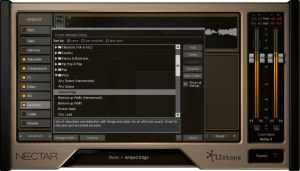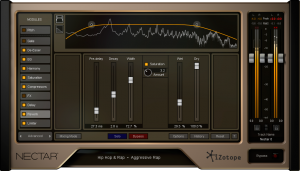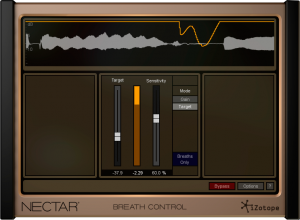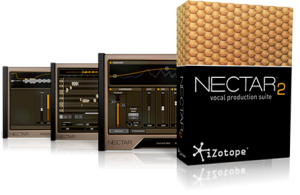Review: iZotope Nectar 2 Production Suite, by Ari Raskin
iZotope, makers of some of the most advanced and comprehensive sound-shaping plugins available, and probably best known for their all-in-one mastering plug-in Ozone, recently released Nectar 2, the update to their all-in-one vocal processing plugin, Nectar.
Nectar 2 is almost like the Ozone of vocal plugins, in that it contains everything needed to process a vocal — while only requiring one insert within your DAW of choice (comes in AAX, RTAS/Audiosuite, VST, VST 3 and Audio Unit formats). Auto pitch correction, gating, de-essing, 12-voice harmonizing, tube or tape saturation emulations, 8-band EQ, 4 different styles of compression, digital or analog-style delays, EMT 140-emulated plate reverb and limiting…plus additional effects like distortion, phaser/flanger/chorus and some subtle to freaky echo stuff — it’s all packed in there, and the user can use any combination or all of the above tools at once and in any sequence.
But wait! There’s more…If you purchase Nectar 2 Production Suite (MSRP $299, street price of $249), you also get the Breath Control plug-in, and the hugely useful Nectar 2 Pitch Editor (which is sort of like a simplified Melodyne, more on that later).
Preset for Stun
Nectar 2’s main focus is probably its vast menu of 150+ presets that handle everything required in the world of vocal mixing so that you can start with a dry vocal and, in an instant, effortlessly dial up a fully-produced vocal sound.
When I was first introduced to Nectar a couple of years ago, my initial impression was that it was designed less for experienced mixers and more for musicians and novice engineers who might not have a well-refined mental palette of vocal tones and effects, or don’t know how to quickly achieve the sounds they want. More experienced mix engineers would probably tend to carve their vocal sounds from scratch, using a variety of different insert plugins and aux sends, tailoring them to the song, and translating the ideas in their heads to numerous plug-in settings.
For most musicians and producers though, who don’t regularly focus all of their brain power on mix techniques, the presets Nectar 2 offers can be a HUGE boost to one’s repertoire of soundscapes.
It should be noted however that Nectar 2’s preset vocal chains can be appreciated by more than just the novice engineer. More experienced mix engineers may find Nectar 2’s preset menu valuable as well, in that going down the list can be an eye (or ear)-opening experience. Nectar 2’s preset menu is full of a wide variety of vocal processing vibes, from light tonal enhancers to indie rock-style dude shouting in a bathroom-type sounds to freaky harmonized alien dance stuff. Flipping through these programs can often introduce even more experienced mixers to sonic ideas they might not have had otherwise.
This is the thing though — while Nectar 2 at first appears as though it’s main function is to flip through a comprehensive list of well-titled banks and presets (like “Male Vintage” [Soul & RnB], “Sampled Vocal Hook” [Dance and Electronic], “Indy Folk & Sons” [Alternative & Indie], etc.) and instantly get a polished vocal sound, presets are just the start of its functions.
In fact, vocal processing is just one of Nectar 2’s literally zillions of potential uses. By skipping past the presets menu and opening Nectar 2’s “Advanced” window, one has access to a host of all kinds of individual plugins within the plugin, from harmonizers to distortions to delays to compressors to EQ’s to de-essers and more.
There’s no reason why you couldn’t use Nectar 2 with its four styles of compression (digital, vintage, optical or solid state) as a kick drum compressor, or as a steep resonant filter for samples, or as a plate reverb return off a snare send, or as a chorus for your guitar tracks. In fact, aside from its CPU usage drawbacks (more on that later), you could literally mix an entire album using just this plugin. It does virtually everything…and does it well.
Reverb Revelation
Like all iZotope products, the sound quality and flexibility of each of Nectar 2’s many functions is generally excellent. Warm and smooth to hi-fi and wide to ugly and grungy, it all sounds great. Nothing sounds cheap or thin.
In this update to Nectar, the folks at iZotope have modeled and emulated the classic and standard EMT 140 analog plate reverb and it’s one of the great features of the plug-in.
While I didn’t have a real EMT 140 on hand for this review, just sonic memories from the days when I used to use them regularly (before the in-the-box era), I did compare Nectar 2’s plate to equivalent settings on the D-Verb and Lexicon LexVintagePlate plugins. The iZotope offering definitely won as far as feeling the closest to an analog reverb and sounding the realest. It was the most 3-D-ish and thickest sounding of the 3 plate simulations, although the LexVintagePlate had a little more of the shimmer that a good 140 has.
However, while the realistic plate emulation is a great new feature, I found it sort of shocking that in a plugin filled with so many options and parameters, designed to achieve practically any sonic vibe, plate reverb is the only style of reverb Nectar 2 offers. No hall, chamber, room, spring or ambience? We have all types of compression styles, EQ’s, delays, different distortions included…but plate is the only type of reverb useful for vocals?
I’m not sure whose idea that was. I will say though, when flipping through the presets, they all sound vastly different from each other so you’d never notice that they all happen to be using the same basic reverb algorhithm.
Breath Control to Major Ari
Also broken out into a separate plugin in Nectar 2 (Production Suite version only) is the Nectar 2 Breath Control plug-in. It’s almost like a noise gate in that it gets rid of unwanted artifacts, but this plugin manages to magically target only breaths. How it works — I don’t know, I’m guessing it detects sounds without a low fundamental tone and considers them breaths…who knows…but it works, and it is easy to use. (Editor’s note: According to iZotope, it detects the harmonic profile of breath sounds.)
Are breaths something that should always be removed? Definitely not. Sometimes breath noises are the enemy, sometimes without them, a vocal performance sounds clearly edited. I don’t know how necessary this feature of Nectar 2 is, but it is a cool idea anyway, and once in a while it could come in handy. (Editor’s note: According to iZotope, Breath Control doesn’t “remove” breaths, it attenuates them by a user defined dB amount in Gain mode, or adds/reduces gain as needed to make all breaths the same consistent volume level in Target mode.)
Another new feature new to Nectar 2 is the Harmony module, which provides up to 12 voices (or up to 4 in automatic mode) to harmonize with your vocal track (or saxophone, or guitar solo), controlled automatically on-screen or by playing the notes on a midi controller. Being able to play vocal harmonies on a keyboard and hear them is super cool, and a great way to make clients and children giggle too. I got a MIDI controller hooked up to Nectar 2 in seconds, with no thinking or effort to get it running.
Does Nectar 2’s new harmonizer sound real, like a choir of singers? No. Do any harmonizers? No. I’d say it sounds smoother and richer than most other harmony-generating plug-ins out there though.
Then we have the final feature of the Nectar update — Nectar 2 Pitch Editor (also only part of the Production Suite version), which benefits from improved workflow and enhanced DSP now that it’s been broken out into a separate plugin.
There’s actually two pitch correction types within the new Nectar: Pitch, which is essentially Auto-Tune-style tuning for effortless real-time pitch correction and/or T-Pain effects; and the separate graphical Pitch Editor plug-in, which corrects vocal pitch based on average tuning (so that your vibratos remain in tact), Melodyne-style.
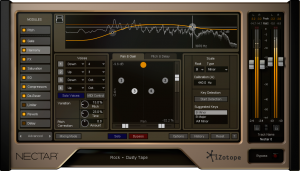
Nectar 2’s Harmony Module intelligently generates in-key harmonies, using the lead vocal as a guide.
It’s incredibly easy to use (I figured this program out on my own in probably a minute), it works well and it sounds good. It’s not as in-depth and feature-laden as Melodyne, it doesn’t tune groups of background vocals or notate your vocal performance automatically, but I think for 95% of lead vocal tuning applications, Nectar 2 Pitch Editor has everything you need. Between the Pitch Editor plug-in and the real-time pitch corrector that Nectar 2 includes, you’re good. There’s essentially no need for Melodyne or Autotune if you own Nectar 2.
CPU Drain Vs. Big Brain
However, with all of its features disengaged except for the Pitch module, Nectar 2 did use more CPU processing power than the equivalent Auto-Tune Evo or Auto-Tune EFX plug-ins did. In fact, Nectar 2’s CPU usage is probably its main drawback. As an example, when running a very light 88.2kHz session made up of just a guitar and a vocal track and no other plug-ins, the CPU usage read 1% initially (I did my testing in ProTools 10 Native running on a late 2009 Mac Pro 2.93 GHz dual Quad-Core with 16GB of RAM).
Add in Nectar 2 in default mode with no processing applied, and the CPU usage jumped to 4%. Throw just the Pitch module on and we’re up to 10%. (The equivalent but more flexible Auto-Tune Evo showed up at only 5% system usage). Add in the plate reverb and the CPU meter jumped to 20%. Add harmonizer and we’re up to 33% system usage. Most of the presets took up somewhere between 25% to 45% of the system’s available CPU power…and that’s with just one instance of Nectar 2.
When using this plug-in on a lead vocal, especially in sessions with high sample rates or high track counts, it may be wisest to get your setting and then burn it in (on a new playlist, of course).
Yes, Nectar 2 can eat up your available CPU power, but when one opens the plug-in and explores its capabilities, it becomes evident why Nectar 2 can weigh down your processor so much. Menus within menus, numerous real time metering and analysis displays running simultaneously, amplitude-based effects on top of time-based effects on top of pitch-based effects, a very detailed and comprehensive interface filled with well-organized menus and windows within…like many of iZotope’s other products, Nectar 2 is simply a beast.
Granted, Nectar 2 can get pretty in-depth in its capabilities (aka complicated), but that’s only if you want it to be. Upon opening the plugin, the user is immediately shown Nectar 2’s list of vocal processing presets. That’s the mode iZotope seemingly wants the user to try first. Many users won’t go beyond this list of presets, and for them, Nectar 2 is a very simple experience.
If however the user wants to go a step further, the startup “Overview” mode allows quick and simple tweaks of basic parameters for easy sound manipulation. Wanna tweak sounds all the way? Enter the “Advanced” mode and get full access to the 11 effects modules’ parameters within.
Nectar 2 has a plethora of settings that can be tweaked, from utility settings like it’s various meters’ response times and latency reduction options to how many levels of undo history Nectar 2 keeps in its RAM, to how tight of a Q the user prefers the EQ to use as it’s default bandwidth setting, to whether you prefer synth style resonant filters to more typical and less-obtrusive filters, from basic serial to the more advanced parallel-style of compression, to peak or RMS-type detection…if I were to go on about all the individual settings that can be tweaked within Nectar 2…I don’t want to even think about that.
The Final Verdict
To sum it up, Nectar 2 at first appears to be an all-in-one vocal processor based on a menu of presets, but it is actually an extremely in depth-channel strip, capable of performing virtually any sonic task to any track, not just vocals.
Nectar 2 has some great new features, and because of the new Pitch Editor and Plate reverb emulation as well as the new presets, users of the original iZotope Nectar may find it useful to upgrade. For its price, Nectar 2 is a pretty amazing deal.
Of all its capabilities, I was personally most excited by the new Pitch Editor plug-in, but there’s so much functionality in Nectar 2 that any user can surely find multiple worthwhile features. Just as far as its presets, this is a very serious program. Add in all the different types of processors this tool includes, and their vastly tweak-able parameters, and you have one the most powerful and versatile plug-ins in existence.
— Ari “R.E. Thuggz” Raskin is a NYC-based Grammy-nominated producer/engineer/mixer and guitarist specializing in a variety of musical genres. Recent projects include Pusha T, Lil Durk, Jeremih, Claude Kelly, Elli Espi, Theophilus London, Johnny Gill, Talib Kweli, Karmin and Justin Bieber. For a more comprehensive discography, please visit http://www.AriRaskin.com







